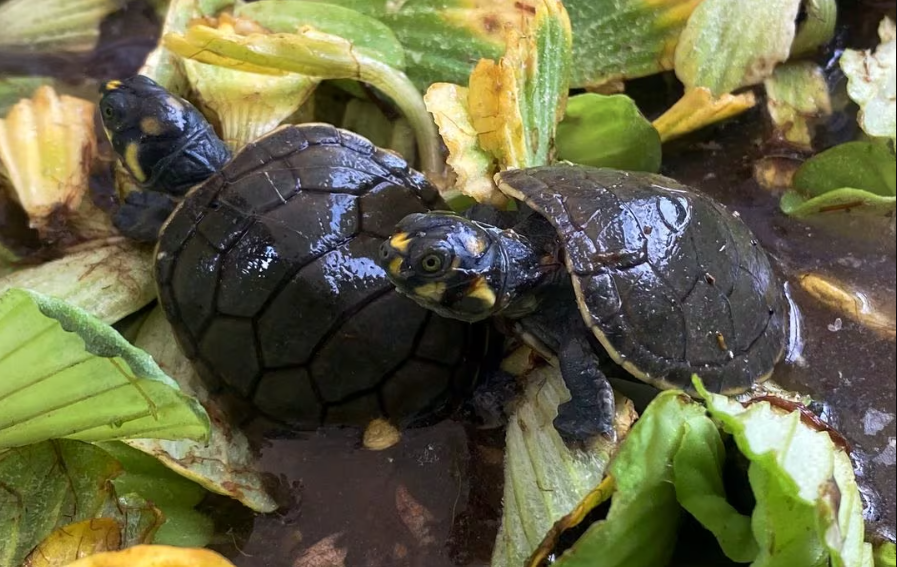
©REUTERS/Alfredo Galarza
Pre-reading questions:
I will read each question. Then, please answer them.
- What role do you think turtles play in their ecosystems, and why might their preservation be important?
- What is deforestation, and how do you think it could impact conservation efforts in rainforests?
Vocabulary:
I will read the words, meanings, and sample sentences. Then, repeat after me.
- passionate /PASH-uh-nit/
- threaten /THRET-n/
- consequence /KON-si-kwens/
- capacity /kuh-PAS-i-tee/
- absorb /ab-SAWRB/
[adjective] – showing strong emotions or intense devotion
The passionate artist poured her heart into every brushstroke, creating a masterpiece.
[verb] – to express an intention to harm or cause damage; to pose a danger or risk to someone or something
The endangered species was threatened by habitat loss and poaching.
[noun] – results or effects of a particular action or situation
The economic downturn had severe consequences for small businesses in the area.
[noun] – the ability or power to do, experience, or understand something
The stadium has a seating capacity of 50,000 spectators.
[verb] – to take in or soak up a substance
Plants absorb sunlight during photosynthesis to produce energy.
Article reading:
Please read the whole article. Then, I will check your pronunciation and intonation.
In the verdant Amazon region of Peru, a dedicated environmental initiative is underway to bolster the population of yellow-spotted Amazon river turtles, known as taricayas. A group of passionate biologists recently released a substantial cohort of 3,200 turtles into the river as part of a comprehensive conservation program, aiming to revive the taricaya species threatened by hunting. The expedited release, prompted by an intense heat wave and drought, shortened the turtles’ usual incubation period from 60–72 days to approximately 45 days. These tiny hatchlings, measuring only a few centimeters, were carefully transported to the river’s edge in containers and set free into the aquatic environment with the assistance of local children.
The accelerated hatching of turtles in Peru’s Amazon is linked to higher temperatures and a significant drought, which are consequences of the El Niño climatic phenomenon. El Niño, causing an increase in Pacific Ocean temperatures, leads to various meteorological effects, including heavy coastal precipitation, heat waves, and Amazon droughts. Preserving the Amazon rainforest is vital for mitigating catastrophic climate change due to its immense capacity to absorb greenhouse gases. Despite this urgency, substantial portions of the Peruvian Amazon have succumbed to deforestation over the past two decades. Biologist Zabryna Pipa Perea, representing the Amarumayu Movement dedicated to Amazonian fauna preservation, stressed the release of 3,200 turtles, totaling 23,000, as a significant contribution to the species’ recovery.
The accelerated hatching of turtles in Peru’s Amazon is linked to higher temperatures and a significant drought, which are consequences of the El Niño climatic phenomenon. El Niño, causing an increase in Pacific Ocean temperatures, leads to various meteorological effects, including heavy coastal precipitation, heat waves, and Amazon droughts. Preserving the Amazon rainforest is vital for mitigating catastrophic climate change due to its immense capacity to absorb greenhouse gases. Despite this urgency, substantial portions of the Peruvian Amazon have succumbed to deforestation over the past two decades. Biologist Zabryna Pipa Perea, representing the Amarumayu Movement dedicated to Amazonian fauna preservation, stressed the release of 3,200 turtles, totaling 23,000, as a significant contribution to the species’ recovery.
Comprehension questions
I will read each question. Then, please answer them based on the article.
- Why did the passionate biologists release 3,200 turtles into the river in Peru’s Amazon?
- What challenges did the taricayas species face that led to the comprehensive conservation program?
- How was the incubation period of the turtles affected by the intense heat wave and drought?
- What role did local children play in the release of the tiny hatchlings into the river?
- According to the article, what are the consequences of the El Niño climatic phenomenon on the hatching of turtles in Peru’s Amazon?
Discussion questions
I will read each question. Then, please answer them.
- Have you or someone you know ever participated in an environmental conservation initiative or program? If yes, can you share the experience and the impact it had? If not, would you consider getting involved in such initiatives in the future? Why or why not?
- Have you ever witnessed or learned about the consequences of climate change in a specific region? If yes, how did it affect the environment and the community? If not, how do you think initiatives like releasing turtles in Peru’s Amazon contribute to addressing climate change, and do you believe more efforts are needed in this regard?
- Do you agree that the release of 3,200 turtles into the river is a significant contribution to the recovery of the taricayas species?
- How might the impact of releasing turtles into the river extend beyond the taricayas species and contribute to the overall health of the Amazon ecosystem? Provide specific examples or reasons for your response.
- Considering the challenges faced by the Amazon rainforest, such as deforestation, how crucial do you think conservation programs like the one discussed in the article are for maintaining biodiversity and mitigating climate change? Support your viewpoint with evidence from the article or your own knowledge.